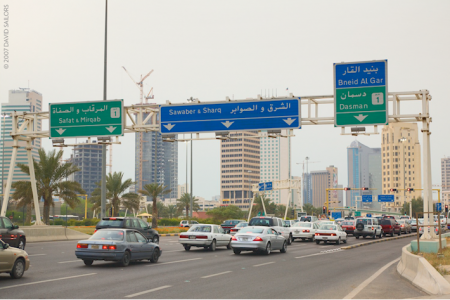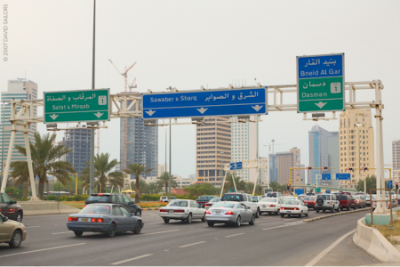

Kuwait has a good road system. All signs are in English and Arabic. The major north-south roads are effectively freeways numbered Expressway 30, 40, etc. These are traversed by increasingly widely spaced ring roads named First, Second, etc, making navigation fairly easy.
Public Transport
Kuwait’s public transport is adequate with three companies (KPTC, City Bus, and KGL) running dozens of routes in every major city. Waiting times for buses range from one minute for most frequent routes to fifteen minutes for less used routes. All buses are equipped with air-conditioners and usually one can find a seat without much trouble. Although, during peak hours (7-9AM, 2-4PM, 8-9PM) most routes are packed and public transport should be avoided for those seeking comfortable traveling. It must also be noted that although areas with the expatriate majority are covered with many routes, Kuwaiti residence areas are scarcely connected with public transport buses and are reachable mostly by taxis only.
Taxi These are recognizable by orange license plates and may be hired by the day, in which case fares should be agreed beforehand. Although most taxis have meters these are rarely used and one needs to negotiate a fare beforehand. Share-taxis are also available. Hailing taxis from the road is the most practical approach. However some sources have reported it was not advisable, particularly for females, and they recommend that taxis are booked in advance by telephone from a reputable taxi company. The cream-colored taxis are the cheapest, but also likely to be poorly maintained and possibly dangerously so, considering the general speed and size of the rest of the vehicles on Kuwaiti roads. Orange colored taxis which used to be the most common type of taxis in till the 1970’s have completely disappeared from roads. A standard rate is applicable in most taxis, but those at hotel ranks are more expensive. Naive Westerners routinely pay 2 to 5 times more than the standard rates which are typically KWD0.500 (500 fils) for up to a 5-minute ride plus about 100 fils (KWD0.100) per minute thereafter. The only exception is airport departures which are approximately KWD3. Tipping is not expected, however, you should negotiate fares before boarding the taxi. It is customary to collect all baggage and exit the taxi before offering payment to avoid conflicts or loss of personal property should a taxi driver demand more than the agreed price after arriving at the destination. This way, the passenger can drop the money in the seat and walk away if necessary.
These are recognizable by orange license plates and may be hired by the day, in which case fares should be agreed beforehand. Although most taxis have meters these are rarely used and one needs to negotiate a fare beforehand. Share-taxis are also available. Hailing taxis from the road is the most practical approach. However some sources have reported it was not advisable, particularly for females, and they recommend that taxis are booked in advance by telephone from a reputable taxi company. The cream-colored taxis are the cheapest, but also likely to be poorly maintained and possibly dangerously so, considering the general speed and size of the rest of the vehicles on Kuwaiti roads. Orange colored taxis which used to be the most common type of taxis in till the 1970’s have completely disappeared from roads. A standard rate is applicable in most taxis, but those at hotel ranks are more expensive. Naive Westerners routinely pay 2 to 5 times more than the standard rates which are typically KWD0.500 (500 fils) for up to a 5-minute ride plus about 100 fils (KWD0.100) per minute thereafter. The only exception is airport departures which are approximately KWD3. Tipping is not expected, however, you should negotiate fares before boarding the taxi. It is customary to collect all baggage and exit the taxi before offering payment to avoid conflicts or loss of personal property should a taxi driver demand more than the agreed price after arriving at the destination. This way, the passenger can drop the money in the seat and walk away if necessary.
These are recognizable by orange license plates and may be hired by the day, in which case fares should be agreed beforehand. Although most taxis have meters these are rarely used and one needs to negotiate a fare beforehand. Share-taxis are also available. Hailing taxis from the road is the most practical approach. However some sources have reported it was not advisable, particularly for females, and they recommend that taxis are booked in advance by telephone from a reputable taxi company. The cream-colored taxis are the cheapest, but also likely to be poorly maintained and possibly dangerously so, considering the general speed and size of the rest of the vehicles on Kuwaiti roads. Orange colored taxis which used to be the most common type of taxis in till the 1970’s have completely disappeared from roads. A standard rate is applicable in most taxis, but those at hotel ranks are more expensive. Naive Westerners routinely pay 2 to 5 times more than the standard rates which are typically KWD0.500 (500 fils) for up to a 5-minute ride plus about 100 fils (KWD0.100) per minute thereafter. The only exception is airport departures which are approximately KWD3. Tipping is not expected, however, you should negotiate fares before boarding the taxi. It is customary to collect all baggage and exit the taxi before offering payment to avoid conflicts or loss of personal property should a taxi driver demand more than the agreed price after arriving at the destination. This way, the passenger can drop the money in the seat and walk away if necessary.
Car hire
Self-driven cars are widely available. If you produce an International Driving Permit, the rental company will, at the customer’s expense, be able to arrange the statutory temporary insurance, which is drawn on the driver’s visa. If you arrive at Kuwait International Airport, you will find the car hire companies located in your left after you exit from the baggage claiming area. You can find international companies such as Osoul House and others. If involved in a car accident, do not attempt to move your car until the police arrive and have made a report or you will be arrested.
Self-driven cars are widely available. If you produce an International Driving Permit, the rental company will, at the customer’s expense, be able to arrange the statutory temporary insurance, which is drawn on the driver’s visa. If you arrive at Kuwait International Airport, you will find the car hire companies located in your left after you exit from the baggage claiming area. You can find international companies such as Osoul House and others. If involved in a car accident, do not attempt to move your car until the police arrive and have made a report or you will be arrested.
Self-driven cars are widely available. If you produce an International Driving Permit, the rental company will, at the customer’s expense, be able to arrange the statutory temporary insurance, which is drawn on the driver’s visa. If you arrive at Kuwait International Airport, you will find the car hire companies located at your left after you exit from the baggage claiming area. You can find international companies such as Osoul House and others. If involved in a car accident, do not attempt to move your car until the police arrive and have made a report or you will be arrested.
